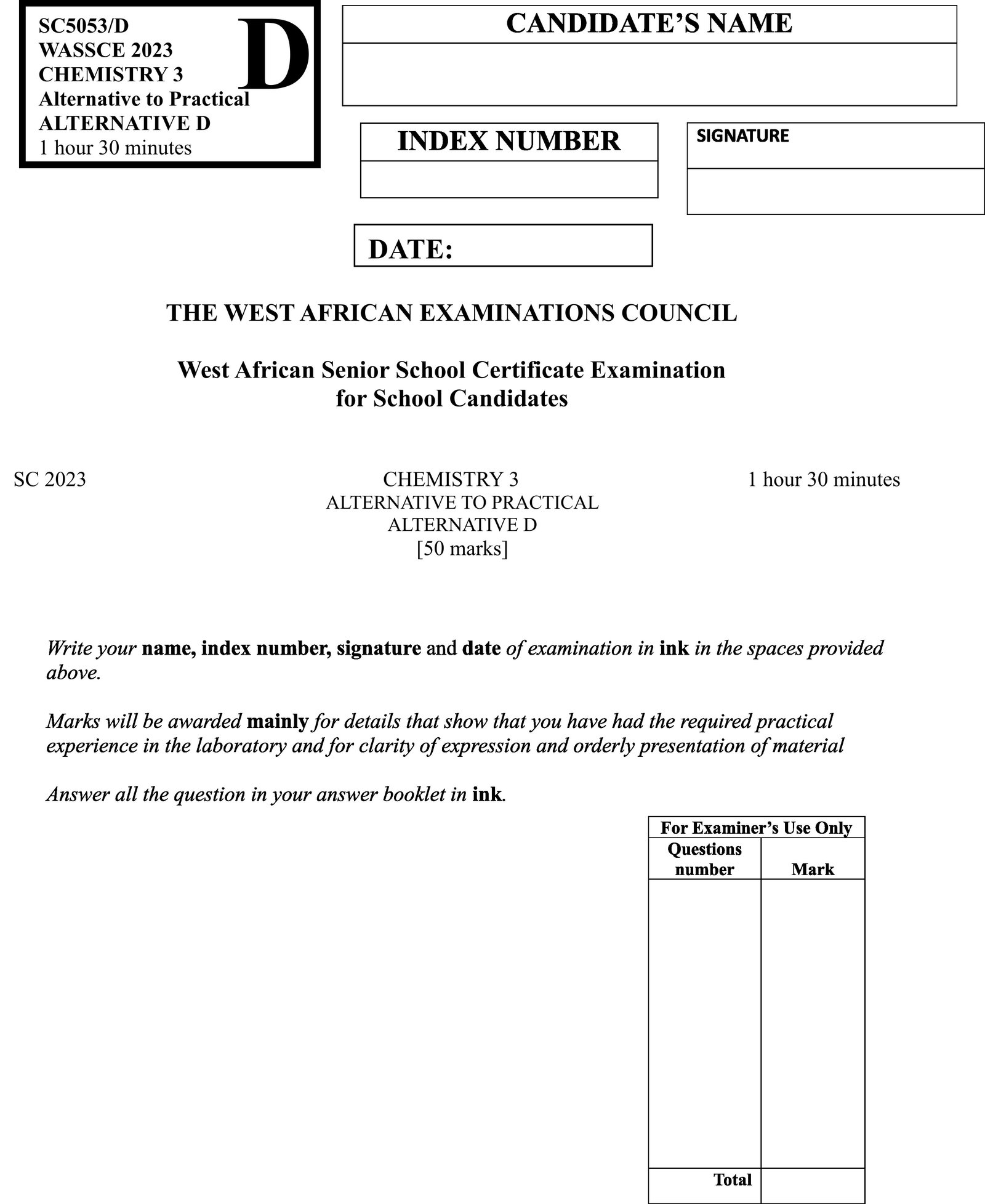

Answer all the questions
A is a solution containing 4.00 g of the acid, HX, per dm3.
B contains 1.00 g sodium hydroxide per 250 cm3 of solution.
A was titrated with 20.0 cm3 portions of B using methyl orange as indicator and the following results were obtained:
| Burette Readings / cm3 | 1 | 2 | 3 |
|---|---|---|---|
| Final reading | 23.10 | 24.60 | 46.30 |
| Initial reading | 1.50 | ||
| Volume of A used | 23.10 | 23.20 |
(a)
(b) From the information provided, calculate the:
The reaction equation is:
HX(aq) + NaOH(aq) → NaX(aq) + H2O(l)
Relative Atomic Masses:
H = 1.0, O = 16.0, Na = 23.0
[18 marks]
| Burette Readings / cm3 | 1 | 2 | 3 |
|---|---|---|---|
| Final reading | 23.10 | 24.60 | 46.30 |
| Initial reading | 0.00 | 1.50 | 23.10 |
| Volume of A used | 23.10 | 23.10 | 23.20 |
= 23.13 cm3
(a) C is a mixture of two inorganic salts. The following tests were carried out on C. Copy and complete the table.
| Test | Observation | Inference | |
|---|---|---|---|
| (a) (i) | C + distilled water + filtration | Partly dissolves to give a colourless solution and a white residue | |
| (ii) | Filtrate + NaOH(aq) in drops then in excess |
White gelatinous precipitate formed Soluble in excess |
|
| (iii) | Filtrate + NH3(aq) in drops then in excess |
Precipitate dissolves | |
| (iv) | Filtrate + dil HNO3 + AgNO3(aq) + NH3(aq) |
Cl− confirmed | |
| (v) | Residue + dil HCl + heat |
CO2 gas evolved |
[12 marks]
(b) Copy and complete the following table stating what would be observed in each case if the test were performed as indicated.
| Test | Observation | |
|---|---|---|
| (b)(i) | Pb(NO3)2 + distilled water | |
| (ii) | Portion from (b)(i) + NaOH(aq) in drops then in excess |
|
| (iii) | Portion from (b)(i) + NH3(aq) in drops then in excess |
|
| (iv) | Portion from (b)(i) + KI |
[6 marks]
(a) completed Table.
| Test | Observation | Inference | |
|---|---|---|---|
| (a) (i) | C + distilled water + filtration | Partly dissolves to give a colourless solution and a white residue | C contains both soluble and insoluble salts |
| (ii) | Filtrate + NaOH(aq) in drops then in excess |
White gelatinous precipitate formed Soluble in excess |
Al3+ present |
| (iii) | Filtrate + NH3(aq) in drops then in excess |
Precipitate dissolves | Al3+ confirmed |
| (iv) | Filtrate + dil HNO3 + AgNO3(aq) + NH3(aq) |
White precipitate formed, dissolves in excess NH3 | Cl− confirmed |
| (v) | Residue + dil HCl + heat |
CO2 gas evolved | CO32− present; residue is likely a carbonate |
(b) Complete table with stated Observation under given test performed.
| Test | Observation | |
|---|---|---|
| (b)(i) | Pb(NO3)2 + distilled water | Colourless solution formed |
| (ii) | Portion from (b)(i) + NaOH(aq) in drops then in excess |
White precipitate formed Insoluble in excess |
| (iii) | Portion from (b)(i) + NH3(aq) in drops then in excess |
White precipitate formed Insoluble in excess |
| (iv) | Portion from (b)(i) + KI | Bright yellow precipitate formed |
(a) Name a suitable drying agent for each of the following gases:
[2 marks]
| Gas | Drying Agent |
|---|---|
| NH3 | Quicklime (CaO) |
| CO2 | Concentrated H2SO4 |
(b) State two chemical tests that could be used to show that a sample of bread contains starch and protein.
[2 marks]
Test for Starch:
Add iodine solution to the bread sample.
Result: A blue-black coloration confirms the presence of starch.
Test for Protein:
Add Biuret reagent to the sample.
Result: A purple or violet coloration indicates the presence of protein.
(c) Explain briefly each of the following statements:
[4 marks]
(i) HCl conducts electricity in solution:
Although HCl is a covalent compound, when dissolved in water, it ionizes completely to produce H+ and Cl− ions.
Result: The free ions in solution allow the solution to conduct electricity.
(ii) Hydration of NaCl crystals with CaCl2 traces:
Calcium chloride is a hygroscopic substance, meaning it readily absorbs moisture from the air.
Result: This causes the dry sodium chloride crystals to become hydrated when exposed to the atmosphere.
(d) Name a liquid substance that could be used in the laboratory for:
(i) dissolving dry mortar on floor tiles;
(ii) removing KMnO4 stains;
(iii) drying acid anhydrides.
[3 marks]
| Purpose | Liquid Substance | |
|---|---|---|
| i | Dissolving dry mortar on floor tiles | Hydrochloric acid (HCl) |
| ii | Removing KMnO4 stains | Oxalic acid solution |
| iii | Drying acid anhydrides | Concentrated sulfuric acid (H2SO4) |
(e) A solution of HCl was titrated with sodium hydroxide solution.
State three precautions that are necessary when carrying out the experiment.
[3 marks]
Precautions: